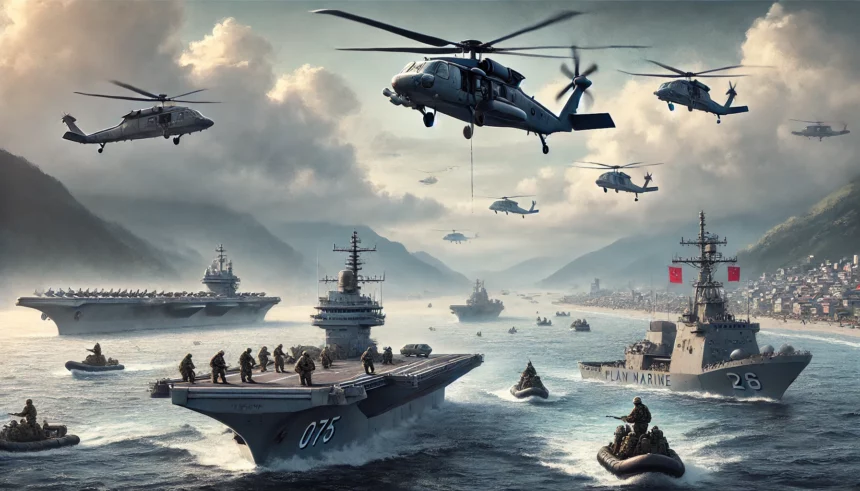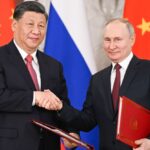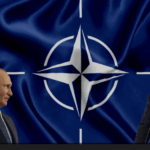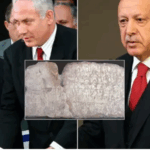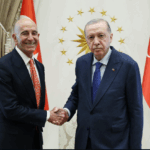Summary by Geopolist | Istanbul Center for Geopolitics:
The essay offers a thorough analysis of China’s developing amphibious warfare capabilities, highlighting their doctrinal development, historical foundations, and contemporary forces that could assist future military operations, especially with reference to Taiwan.
Chinese Amphibious Warfare: Prospects for a Cross-Strait Invasion, the most recent volume from the Naval War College’s China Maritime Studies Institute (CMSI), provides a thorough examination of the PLA’s readiness, difficulties, and security implications on a regional and international scale.
Historical Foundations and Doctrinal Development
China’s current tactics are based on its history of amphibious warfare. Important historical points consist of:
Mao Zedong’s Early Ambition: Prior to the United States’ involvement in the Korean War, in 1950, Mao had planned to invade Taiwan across the Taiwan Strait. Important lessons learned from early operations, such the successful 1950 Hainan Island landing and the unsuccessful 1949 Kinmen invasion, are still incorporated into China’s military strategy.
Symbolism in History: In contemporary Chinese discourse, Admiral Shi Lang’s invasion of Taiwan in 1683 is frequently cited as a historical model for Taiwan’s reclamation.
Strategic Shifts Post-1950s: China turned to seizing tiny offshore islands while indefinitely delaying large-scale operations in response to failures and the supremacy of the U.S. Seventh Fleet in the Taiwan Strait.
This cumulative experience is reflected in the present amphibious doctrine, which emphasizes coordinated operations across various domains, including air, sea, land, and information, while integrating rapid assault tactics and psychological warfare.
Modern Amphibious Forces
Through improved training, technology advancements, and organizational reorganization, China’s amphibious warfare capabilities have grown dramatically. These consist of:
PLA Ground Forces (PLAGF):
Although the majority of China’s sealift capabilities are constituted by Amphibious Combined-Arms Brigades, their present training levels indicate that they are better equipped to seize outlying islands than launch a full-scale invasion of Taiwan.
PLA Navy Marine Corps (PLANMC):
Since 2017, the PLANMC has grown from two brigades to eight, with a total strength of nearly 30,000.
Its strategic significance is demonstrated by its twin function as an expeditionary force for operations abroad and a major actor in scenarios of an invasion of Taiwan.
PLA Navy (PLAN) Amphibious Fleet:
China’s emphasis on strategic mobility and force projection is demonstrated by its huge investments in big amphibious assault ships, such as the Type 075 Landing Helicopter Docks (LHDs) and Type 071 Landing Platform Docks (LPDs).
By utilizing China’s extensive shipbuilding capabilities and maritime resources, civilian maritime assets—such as the Maritime Militia—are included into the logistics chain.
Special Operations Forces (SOF):
These troops, which take inspiration from past amphibious operations like the British Falklands campaign and U.S. operations in Grenada, are assigned with reconnaissance, obstacle removal, and direct strikes.
Enablers of Amphibious Operations:
In the event of an invasion of Taiwan, the PLA Airborne Corps and helicopter units would be crucial. However, there are major obstacles due to training and logistical coordination difficulties.
One important but frequently disregarded component of China’s strategy is mine warfare. Though these activities would also reveal weaknesses to countermeasures, China’s sophisticated minelaying skills would probably be used to blockade Taiwan.
Taiwan Context and Strategic Objectives
Taiwan continues to be a key component of China’s military strategy. Recent advancements consist of:
Increased Military Exercises: In 2024, PLA Navy, Coast Guard, and civilian vessels coordinated in new ways for large-scale operations near Taiwan, which were the biggest maritime manoeuvres since 1996.
Integration Across Domains: China’s plan includes the use of “temporary reserved areas” for aerospace activities and airspace dominance, including repeated incursions into Taiwan’s Air Defence Identification Zone (ADIZ).
Cross-Strait Invasion Strategy:
A planned strategy for an invasion of Taiwan is outlined in the PLA’s Joint Island Landing Campaign:
– Actions for preparation, such as naval and air supremacy.
– Use of concentrated elite forces for deployment and beachhead establishment.
– Subsequent operations to capture and retain key targets on the island.
Challenges and Limitations
China still confronts many obstacles in spite of its quick progress:
Logistical Gaps: Although China’s maritime industry can sustain extensive operations, combining military and civilian resources is still difficult and susceptible to attacks.
Training and Readiness: When carrying out complex tasks, PLA amphibious forces—especially helicopter units and SOF—face operational and coordination difficulties.
Opposition Capabilities: With U.S. military assistance, Taiwan’s defences continue to be a powerful deterrent. China’s invasion plans would be complicated by sophisticated air and sea defence systems.
Strategic Consequences
Conflict in the Taiwan Strait is becoming more likely as a result of the convergence of China’s military modernization, geopolitical aspirations, and historical narratives. The PLA’s Centennial Military Building Goal of 2027, which seeks to fully operationalize Taiwan-focused capabilities, is in line with paramount leader Xi Jinping’s view of Taiwan as the ultimate prize to solidify his legacy.
Urgency for Deterrence:
The window for effective deterrent is closing, the paper cautions. To deter China from trying a military solution, the United States and its allies must strengthen Taiwan’s defences.
Among the actions include boosting cooperative training with Taiwan, increasing arms sales, and thwarting China’s information and psychological warfare initiatives.
Final assesment
This examination of China’s amphibious warfare reveals a force that is quickly modernizing and has the potential to seriously destabilize the region. Despite China’s remarkable military expansion, there is deterrent potential due to its vulnerabilities. In order to avoid conflict and maintain peace in the Indo-Pacific, policymakers, defence planners, and regional stakeholders must have a thorough understanding of these dynamics. The argument that stopping an invasion is in everyone’s best interests is made in the article’s conclusion, which calls for immediate action to strengthen defences.
Read more here.

